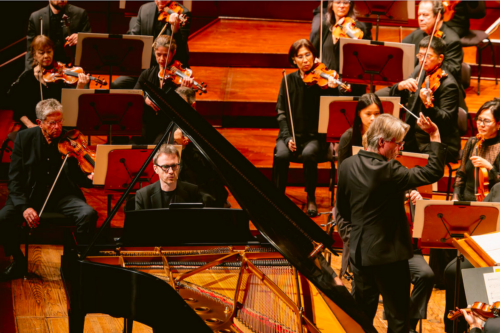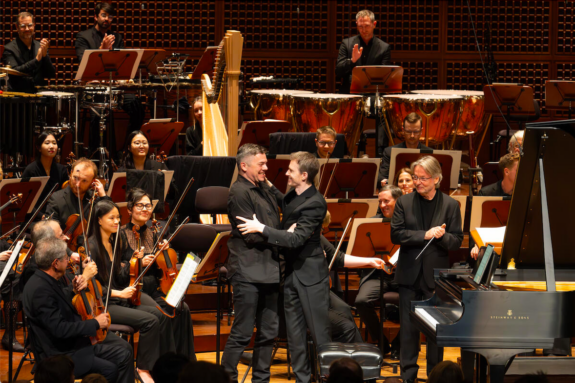 United States Hindemith, Muhly, Bach: Alexandre Tharaud (piano), San Francisco Symphony / Esa-Pekka Salonen (conductor). Davies Symphony Hall, San Francisco, 28.9.2024. (HS)
United States Hindemith, Muhly, Bach: Alexandre Tharaud (piano), San Francisco Symphony / Esa-Pekka Salonen (conductor). Davies Symphony Hall, San Francisco, 28.9.2024. (HS)

Hindemith – ‘Ragtime (Well-Tempered)’; Symphony: Mathis der Maler
Nico Muhly – Piano Concerto
J.S. Bach (arr. Elgar) – Fantasia and Fugue in C minor, BWV 537
Composer Nico Muhly had a clear idea of what he wanted to achieve with his new piano concerto, and he had a specific pianist in mind. The French musical polyglot Alexandre Tharaud had grabbed his attention with a knowledgeable and vivid approach to the music of Rameau. Muhly loved the tension French Baroque composers like Rameau achieved between rigorous structure and unexpectedly soulful harmonies.
Muhly’s approach to his own music played on soulful harmonies and rhythms in such successful works as the operas Two Boys (2011) and Marnie (2018) at the Metropolitan Opera. His connection with San Francisco Symphony as a collaborative partner yielded Throughline, the first new music the orchestra presented during the pandemic lockdown (if only on video).
The orchestra commissioned this concerto with Tharaud and conductor Esa-Pekka Salonen in mind, and it is a doozy. In its world premiere performance in the orchestra’s first subscription series of the 2024-2025 season, it jumped out of the gate from the first two measures with playful rhythms. Neither the piano nor the orchestra took a breather of more than a measure or two through the piece’s 22 minutes, its three movements tied together without pause.
Salonen and the orchestra seemed to be having a grand time with the often exotic instrumentation, extensive use of brass, six percussionists (and an array of timpani) and woodwinds from piccolo to contrabassoon. It felt like a Baroque ensemble on steroids, bouncing athletically through ever-evolving rhythms with piquant but never raucous harmonies. Sections of the orchestra often doubled the piano’s phrases to paint them in different colors.
The lively opening movement included gestures that emulate, if not exactly quote, the music of Couperin and Rameau. Lots of busy flourishes from the piano, played with vigorous expression by Tharaud, established the character of the concerto. As the final measures of the first movement died down, the slow second movement introduced greater clarity to the dense harmonies and settled into quiet floating chords with overtones of jazz textures. An oboe intoned a languid tune as Tharaud added decorative embellishments, before settling into a lovely duet with principal viola Jonathan Vinocour.
Glissandos from the low brass and strings brought in a sense of agitation. Percussion threatened to destroy the floating expressiveness, but the interruption receded into a variation of the soft chords that began the movement. Before the final chords could fade away, the finale entered with chattering, rhythmic chords in the strings and woodwinds.
Broad melodies flowed in octaves over the babbling rhythms, as if experimenting with different ways to combine lyricism and rhythms. One of the tunes reminded me of a phrase from Stephen Sondheim’s ‘Children Will Listen’. More glissandos signaled that the final pages were coming. An insistent rhythm layered itself on itself through the orchestra in a sort of percussive counterpoint and built to a crisp finish.
‘I need to hear this a few more times’ was my first reaction, because it was a joyous ride that I wanted to get to know better.
Salonen’s programming around this intriguing piece ingeniously offered music that reflected aspects of Muhly’s concerto. The mid-twentieth-century composer Paul Hindemith’s impish ‘Ragtime (Well-tempered)’ opened the concert. The four-minute wingding applied ragtime rhythms and early jazz instrumentation to the oh-so-familiar C minor fugue from J.S. Bach’s Well-Tempered Clavier, Book I, foreshadowing some ideas that Muhly, frankly, did much better.
After intermission came early-twentieth-century English composer Edward Elgar’s lavishly orchestrated version of another C minor Bach work, an organ fantasia and fugue that he played when he was primarily an organist. Written in 1921, the piece is the polar opposite of the late twentieth-century trend for ‘historically informed performance’. Extravagant does not begin to describe the full-bodied sound and gaudy colors of this version. Once again, Muhly’s update struck a more appropriate balance.
The concert closed with a ringing performance of Hindemith’s Symphony: Mathis der Maler, which this orchestra has not played since 1987 (under Herbert Blomstedt). The three movements, extracted from music Hindemith wrote for the opera of the same name, expand on chorales and plainchant, brought up-to-date with the power of a full philharmonic orchestra. The brass, especially, covered itself with glory.
Harvey Steiman
Featured Image: Composer Nico Muhly (left) with pianist Alexandre Tharaud as conductor Esa-Pekka Salonen applauds © Kristin Loken

When would these works be presented for purchase please.
Absolutely wonderful to listen with. Thank you.
S&H replies: if anyone has this information please let us know.